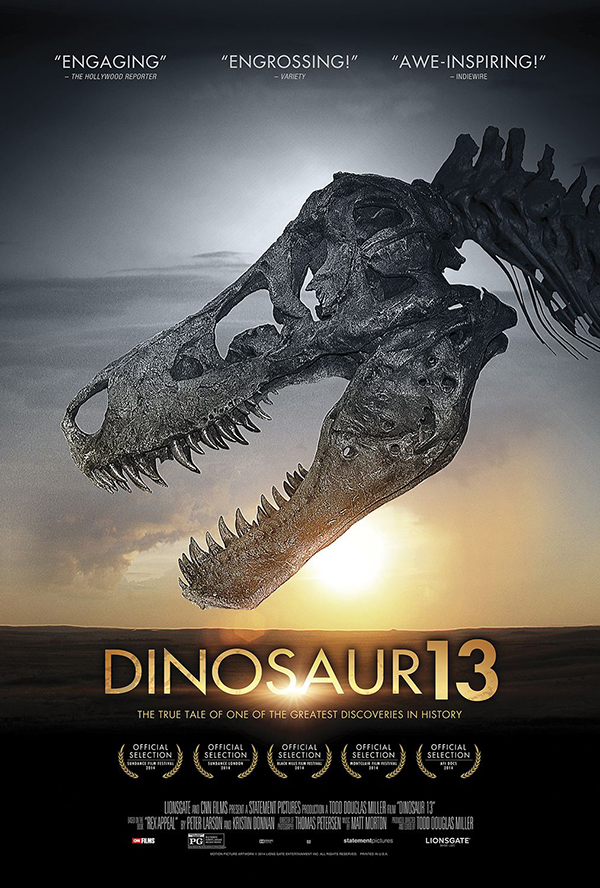
by Allison Mills Tuesday, August 12, 2014

'Dinosaur 13' opens in theaters Friday, Aug. 15.
As the most complete Tyrannosaurus rex skeleton ever found, “Sue” is an icon. She even has her own logo and her own Twitter account. Sue made history in the early 1990s, and not just for being a major paleontological discovery: The human drama that unfolded afterward is the focus of the 2002 book “Rex Appeal,” and, now, the subject of a new documentary, “Dinosaur 13,” to be released in theaters Aug. 15.
The film’s title references the fossil’s discovery as the 13th intact T. rex skeleton to be uncovered. Now totally clear of rock, the fossil legend headlines at the Field Museum of Natural History in Chicago, but the bones had a long journey to their current location and it all started at a cliff in South Dakota.
In 1990, paleontologist Peter Larson, his brother Neil and a team of collectors from the Black Hills Institute of Geological Research were on a dig in the South Dakota Badlands. One of the crew, Sue Hendrickson, went for a hike and started finding bone chips littering the base of an outcrop. She looked up and upon finding three sizeable vertebrae sticking out of the cliff, ran back to camp. The Larsons, Hendrickson and the rest of the team had made the largest discovery of their lives, and they subsequently spent months excavating the skeleton.
In the early scenes of the film, it excels at drawing out the sense of discovery, and by weaving in original footage, it evokes an intense feeling of being in the moment. The documentary deepens this connection with excellent landscape images. There is nothing quite like a badlands vista — the white sun baking bare rock, molting shales flaking off fantastical spires, and vast flatlands pushing back the horizon. The beauty of the landscape and the accompanying music create a sense of awe, carefully designed to make the film’s next part seem like falling off a cliff.
Two years after the excavation of the skeleton, more than 30 FBI agents and the South Dakota National Guard swarmed the Black Hills Institute and confiscated Sue and all related records.
The film’s director and producer, Todd Douglas Miller, draws out the story’s pathos. Seamlessly interweaving footage of locals chanting in protest, the paleontologists shedding genuine tears and armed forces escorting the boxed skeleton, the film oozes a sense of infuriation.
This is even more evident when the Black Hills team is arrested and slapped collectively with a 153-charge, 39-count federal indictment. For Peter Larson, all but two of the charges were dismissed. He was found guilty of customs violations and sentenced to two years in federal prison. In the film, Larson recalls one of the prison guards reading from his paperwork that the reason listed for his incarceration was “a failure to fill out forms properly.”
Viewers will likely find themselves identifying with the paleontologists, but the film overreaches in trying to liken Larson’s incarceration with Sue’s “incarceration” and preparation for auction. Furthermore, the filmmakers gloss over complex and important issues involved in paleontological research: the balancing act of reconciling major personal disruption with unbiased research amidst intense media coverage; academia’s disdain for commercial fossil collection; and conflicts over ownership and property rights; and the laws surrounding the collection of fossils.
As Larson’s lawyer acknowledges in the film, “Sue came out from an absolute legal netherworld.” That netherworld lies at the intersection of tribal, federal and private lands. Sue was found on a tribal rancher’s trust lands, land overseen by the federal government for an individual or tribe. The research team thought they were on private land and, indeed, old footage with the land owner at the dig site was used as evidence of this. (If nothing else, the ensuing confusion carries the lesson that a researcher should always know the land-use restrictions of their field sites.)
In the courts, the federal government, Cheyenne River Sioux and rancher Maurice Williams all contended with the Black Hills Institute for ownership of the skeleton. In the end, Williams won out and collected more than $7 million for Sue at auction.
Williams, who passed away in 2011, does not appear in the film. But neither do any members of his family or the Cheyenne River Sioux tribe. According to Newsweek, the tribe declined to do any interviews, but the lack of these voices is by far the most disappointing part of “Dinosaur 13,” leaving it feeling unbalanced.
Despite this and the missing nuance of other scientific issues, the documentary is worth watching — at the very least for the badlands vistas, but also because it’s a story the geoscience community shouldn’t forget.
The film’s trailer can be viewed at http://www.dinosaur13movie.com.
© 2008-2021. All rights reserved. Any copying, redistribution or retransmission of any of the contents of this service without the expressed written permission of the American Geosciences Institute is expressly prohibited. Click here for all copyright requests.